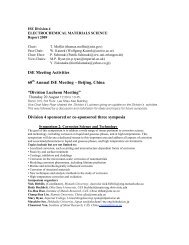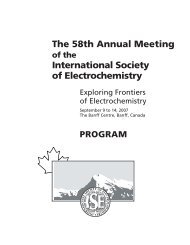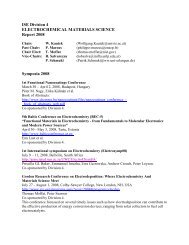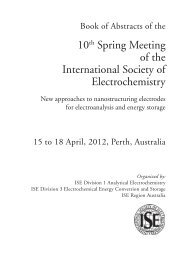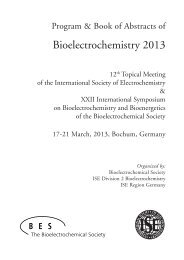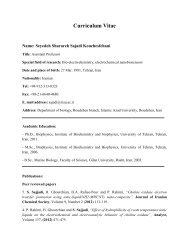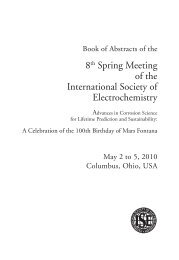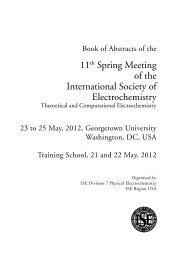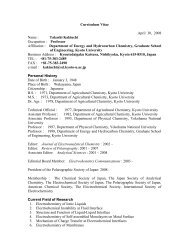8th Spring Meeting of the International Society of Electrochemistry
8th Spring Meeting of the International Society of Electrochemistry
8th Spring Meeting of the International Society of Electrochemistry
Create successful ePaper yourself
Turn your PDF publications into a flip-book with our unique Google optimized e-Paper software.
8 th <strong>Spring</strong> <strong>Meeting</strong> <strong>of</strong> <strong>the</strong> <strong>International</strong> <strong>Society</strong> <strong>of</strong> <strong>Electrochemistry</strong><br />
35<br />
The “Wedging Action” <strong>of</strong> Compounds as a Damage<br />
Process Important to Pr<strong>of</strong>essor Fontana<br />
Roger W. Staehle<br />
Staehle Consulting<br />
22 Red Fox Road<br />
North Oaks, Minnesota 55127<br />
651 482 9493, 651 484 5735 (f)<br />
rwstaehle@gmail.com<br />
Keynote Lectures<br />
“Font” was always interested in expanding corrosion products as important in various<br />
damage processes. Such damage occurs in <strong>the</strong> expansion <strong>of</strong> corrosion products on<br />
reinforcing bars in concrete and welded joints. He also felt that such damage was<br />
important to <strong>the</strong> initiation and propagation <strong>of</strong> stress corrosion cracking. This expansion<br />
<strong>of</strong> compounds, oxides, was first calculated and summarized for various metals by<br />
Pilling and Bedworth (J. Inst. Met. 29, 534, 1923) in 1923. However, <strong>the</strong> forces exerted<br />
by growing crystals was first identified in a reference by Becker and Day (Proc. Wash<br />
Acad Sciences, VII, 283, 1905) in 1905 who referred also to studies by Jean Lavalle in<br />
1853 and by Lehmann in 1888 on <strong>the</strong> same subject. Forces exerted in concrete by <strong>the</strong><br />
expansion <strong>of</strong> corrosion products from corroding reinforcing bars were studied and<br />
forces measured in detail by Rosa et al. (#18 Bu. Standards 1919 GPO) and reported in<br />
1919. Similar work was undertaken in his MS <strong>the</strong>sis and reported by Rosengarth (MS,<br />
1981 Penn State Univ) in 1981. In 1962 Pickering et al. (Corr. Jnl. 18, 1962) showed<br />
that <strong>the</strong> force <strong>of</strong> corrosion products grown in a crevice could be measured for<br />
specimens <strong>of</strong> stainless steel exposed to 200°C chloride electrolytes. In this same paper,<br />
<strong>the</strong>y showed that <strong>the</strong> forces in a crevice would produce sufficient stresses at <strong>the</strong> bottom<br />
<strong>of</strong> a crevice to initiate SCC; <strong>the</strong>reupon <strong>the</strong>y removed <strong>the</strong> crevice element and <strong>the</strong> SCC<br />
continued to grow due only to <strong>the</strong> forces <strong>of</strong> expanding corrosion products inside <strong>the</strong><br />
SCC. This is illustrated in Figure 1. Of substantial economic concern has been <strong>the</strong><br />
growth <strong>of</strong> corrosion products inside <strong>the</strong> superheated crevices <strong>of</strong> tube supports in <strong>the</strong><br />
steam generators <strong>of</strong> pressurized water reactors as summarized by Staehle. Such<br />
expansion causes <strong>the</strong> tubes to deform and sustain SCC at locations <strong>of</strong> high plastic<br />
strains as shown in Figure 2. O<strong>the</strong>r recent results associated with <strong>the</strong> presence <strong>of</strong> lead<br />
impurities in <strong>the</strong>se superheated crevices have shown that <strong>the</strong> lead greatly accelerates<br />
oxidation <strong>of</strong> Alloy 690 tubing (Proc. 5 th CNS SG meet). Pr<strong>of</strong>essor Fontana’s instincts<br />
again demonstrated that his intuitions in corrosion were right.<br />
Fig. 1 Fig. 2



